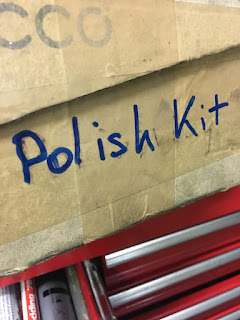The engine for the new sidecar is by no means radical or anything out of the ordinary. Much the contrary, it was the recipe that I came up with for the bumblebee engine, which originally inspired me to reconsider building a XV-based sidecar.
The basis for the engine as such will be a set of XV1100 cases, which are a straight fit into my Gen1 XV750 frame, in order to accept BT1100 cylinders the crankcase mouths have to be enlarged ever so slightly (0.5mm on the diameter to be precise).
The crank is a (once more) a wild mix of a heavy (12kg) XV1100 crank with BT1100 connecting rods and pistons. Crank is a #3 and conrods #5, so black bearing shells was what the factory manual called for.
Even though it makes starting quite a bit more difficult, but the red assembly lube is instrumental in protecting the bearing shells until oil-pressure has built up.
On the TR1-engine I used a holesaw to modify the case mouths, this time I went with a die-grinder and a flap-wheel. Not only was it A LOT quicker, I didn't attempt to break my wrist this time, which I consider a huge plus.
I am not one big into vanity-mods, but I admit I like my XV-engines in all silver.
Also XV1100s don't appear to have this one stud on the right side of the engine.
One of the very minor differences between XV750 and 1100 cases: The later cases lack the boss, which I love to use for the oil-pressure sensor. Guess, I'll have to figure out something along the way.
Aside from the rotating assembly, I planned to use quite a few bits from the original XV750 donor engine as it must have been overhauled only shortly before it failed (because of an incorrect check bolt in the oilfilter-cover preventing any oil-pressure to the head from building up and killing cams and rockers.)
On the subject of failures: When they pulled the crank the first time, the thread on the crank-end got mushroomed slightly and thus the rotor was only on handtight (at best).
Also the oil-seal in the clutch cover was damaged leading to even less oil-pressure...
The left side crankshaft bearing had been removed in the past (most likely because I needed for a TR1 engine and now a good used bearing was installed - we'll see how that fares.) As it was just slightly above freezing in my workshop, the bearing install was rather straight forward.
The crank-install on the other side fought me all the way this time.
With my penchant for ratty mostly black bikes, it might be a bit surprising to some, what I actually have a rather well stacked box with all sorts of polishing mops and the like. To be fair, I hardly ever use it on parts one can see. In this particular case, I polished the guide-rod for the shifter forks. One of those little jobs which helps with silky smooth shifts later on.
With the gearbox installed it was just a matter of bolting the two halves together and calling it an engine. As one of the dowels fell out, it gave me the opportunity to take a picture of just how far you get with a 1 to 1.5mm wide bead of engine silicone.
If the courier-service doesn't let me down, I should have all the missing parts by the end of the week and be able to finish the engine next weekend.























No comments:
Post a Comment